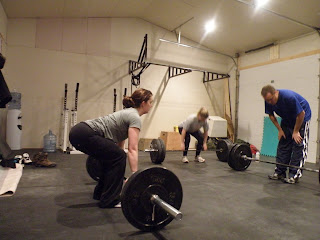
I have noticed there is an inordinate amount of flinching going on these days with the deadlift. What is flinching? Flinching is when the athlete approaches the bar and pulls hard WITHOUT first tightening up, or bracing. It is easy to identify a flincher by the sound of the bar when the athlete executes the movement. A flincher does not create tension under load and therefore creates slack between him or herself and the bar. THis results in a clanging of the barbell as he or she lifts the load. Trying to tighten up while lifting will really mess you up!
To tighten up on the deadlift is to squeeze the abs to the belly button, lift the chest and squeeze the scapula and tighten the lower back. And something new that I learned at the Movement and Mobility Certification with Kelly Starrett is the principle of loading and tensioning. This principle states that the body will activate that part of the body that you first place under load or tension. Of course, with the deadlift, we should be biasing our hamstrings.
Next time you go to do a deadlift, go through the entire process of tightening up just before you actually get your hands on the bar. Then re-tense or reload the hamstrings once you are in position. You do this by lifting the hips just a little before you are about to lift. This will place maximum tension on the hamstrings. Provided you have gone through all the movement prep and you have braced yourself this reloading of the hamstrings will make it impossible to flinch. It also means that your hamstrings will be the first thing to fire under the load of the deadlift.
Try it. It makes a huge difference in the efficiency and thus the safety of the deadlift as you will have further eliminated the potential for movement of the spine under load. It will also enable you to go heavier.
This is a super important point to make, especially on a lift that is so technical. A DL can get up there and it is so important to do it safely, having that tension and tightness BEFORE lifting the weight just makes sense. A good way to know you are tightening (for me anyway) is I will grip the bar, get into position and tighten/lift my chest, the bar is still on the ground but because I am so tight, I feel like I need to lift the bar, like it would feel better to lift it then to stay where I am and tight. So for me, I know I am tightened up when I feel like, it would be easier for me to lift the weight then to stay in my current position. Does that make sense, do other people feel that with the DLs?
ReplyDeleteI totally know what you mean Jane - when I'm ready, have tightened, and lifted my chest, it's like the bar is slightly off the floor (maybe just the slack in the hole of the plates?) And then I actually lift it (after taking a huge breath!)
ReplyDeleteI'll try thinking about my hamstrings next time... they are definitely the sorest after a high rep DL WOD.
When I get in to the heavy heavy weight, that's when I flinch. For me, it's really just a lack of confidence. I'm worried about the start of the lift and once I have the weight off the floor I feel confident. Not good.
ReplyDeleteThinking about my hamstrings and my glutes while bringing my shoulder blades together and tightening up everything makes the ready position feel more secure and that boosts my confidence. Subsequently, I don't feel the need to flinch. When I set up properly my lifts are good and I can generally up the weight more and more.
Charity
This is great info. I was one of the guilty flinchers. I look forward to trying out the above info on my next DL. _mie ka_
ReplyDelete